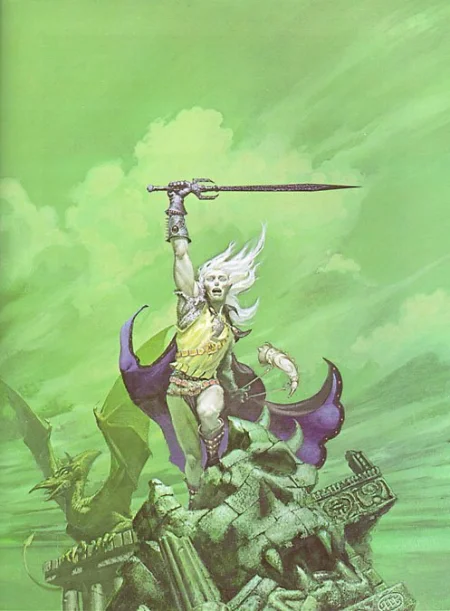Hold
my head
We'll trampoline
Sword
and sorcery and related modes of weird fiction—lost worlds, dying earth, weird
fantasy, sword and planet, cosmic horror—are defined in part by their distance:
at the extreme ends of the earth, in the deep in the recesses of prehistory, on
another world millions of miles away, or so far into the future that our
present era has been forgotten. One way to convey this sense of distance to
readers (or to players of an RPG) is through names. I don’t mean assigning
bizarre combinations of incongruent phonemes to mundane items (in my world,
swords are called vlxizjpartl). I simply meaning evoking a sense of alienness,
of being in a place totally disconnected from this world and its history.
Clark
Ashton Smith is the master of this type of onomastic estrangement. He briefly
outlined his technique in his notebook, collected in The
Black Book of Clark Ashton Smith:
Phonetics
to suggest strangeness grotesquery;
play up less frequent letters;
ch, j, h, qu, sph, y, wh, sm, x, z, ((etc.)) oi, oo (phorf) [sic], ä, etc.
play up less frequent letters;
ch, j, h, qu, sph, y, wh, sm, x, z, ((etc.)) oi, oo (phorf) [sic], ä, etc.
By
“[playing] up less frequent letters,” diphthongs, and consonant blends, Smith
created names that bear no etymological resemblance to any current language,
creating not only an atmosphere of strangeness and grotesquery but remoteness
and alienness.
When
it comes to names that sound vaguely British, but with a weird twist, you can’t
beat Mervyn Peake: Abiatha Swelter, Titus Groan, Fuchsia, Lord Sepulchrave,
Steerpike, Prunesquallor. A reader need only read Prunesquallor's name to
glean something of his character, though this approach, if applied poorly, can
be overbearing and lacking in nuance. I must admit that JK Rowling has a
penchant for these types of names, as well. They have an air of twisted
familiarity. They are uncanny names: they are at home in the English language
but are not English names. They are uncanny names for an uncanny story.
Gene
Wolfe’s approach to naming in The Book of the New
Sun—using Greek and Latin words to describe aliens, space ships, androids,
beam weapons, and genetically-engineered creatures and naming characters after
Classical and Medieval saints—is one of the most innovative and effective
examples of this type of cognitive estrangement that I can think of. It wasn’t
until my second reading of The Shadow of the
Torturer that I realize that I was reading a science fiction novel and
not a fantasy novel. Likewise, it was not until a later rereading that I
understood that all of the names in the book were the names of mostly
lesser-known saints from early Christian history. The story is science fiction
that seems like fantasy; the names are historical but they seem invented. The
story seems like it has no connection to our own world, but it is (probably
some form of) our world; the names seem to have no connection to Wolfe’s own
culture and history, but they do.
In my own writing, I tend to take a little from Smith, a little from Peake, and a little from Wolfe. I strive for etymological distance while sometimes trying to hint at some aspect of the character's personality. At the same time, I reach for Greek concepts when communicating a sense of ancient continuity, hinting that this fantasy world might have some long-forgotten connection to our own. Sometimes making the unfamiliar familiar is as effective an estrangement technique as the reverse.






